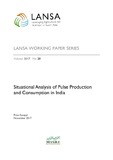| dc.contributor.author | Rampal, Priya | |
| dc.coverage.spatial | India | en |
| dc.date.accessioned | 2017-11-21T14:40:34Z | |
| dc.date.available | 2017-11-21T14:40:34Z | |
| dc.date.issued | 2017-11 | |
| dc.identifier.citation | Rampal, P. (2017) Situational Analysis of Pulse Production and Consumption in India, LANSA Working Paper Vol 2017 No 20. Bighton. IDS | en |
| dc.identifier.uri | https://opendocs.ids.ac.uk/opendocs/handle/20.500.12413/13350 | |
| dc.description.abstract | Encouraging the production and consumption of pulses is in line with the second Sustainable Development Goal’s three-fold objective to end hunger, achieve food security and improved nutrition, and promote sustainable agriculture. This paper discusses the importance of encouraging the production and consumption of pulses, given their nutritional benefits. It gives a situational analysis of the production, consumption and prices of pulses. Further, it describes the various government programmes that have been initiated in India since 2000-01 to increase the production of pulses. This paper undertakes a situational analysis of area, production and yield - state-wise and crop-wise - for 5 major pulses (Bengal gram, red gram, green gram, black gram and lentils), along with that of total pulses, with reference to the time periods in which the various government schemes were launched. It also examines the state-wise growth performance in area, production and yield for these pulses along with an analysis of the share of these pulses in the statistics of total pulses. On the consumption side, the paper analyses the patterns in consumption using the 61st and 68th rounds of the National Sample Survey corresponding to the years 2004-05 and 2011-12. The area and production under pulses has been almost stagnant in the time period starting early 2000. The per capita availability of pulses was less than the recommended dietary allowance (RDA) of 40 g per day even untill 2009-10, in spite of imports. Though the availability has just reached the minimum level of RDA, the volatility in pulse prices is a major issue that needs to be taken care of. This volatility, which alternates between adversely impacting consumers and producers, creates dilemmas for public policy. The paper concludes with policy recommendations. | |
| dc.description.sponsorship | Department for International Development (DFID) | en |
| dc.description.sponsorship | UK AID | en |
| dc.language.iso | en | en |
| dc.publisher | Leveraging Agriculture for Nutrition in South Asia | en |
| dc.relation.ispartofseries | LANSA Working Paper Series 2017; | |
| dc.rights.uri | http://creativecommons.org/licenses/by-nc/4.0/ | en |
| dc.subject | Agriculture | en |
| dc.subject | Nutrition | en |
| dc.title | Situational Analysis of Pulse Production and Consumption in India | en |
| dc.type | Series paper (non-IDS) | en |
| dc.rights.holder | Leveraging Agriculture for Nutrition in South Asia (LANSA) | en |
| rioxxterms.funder | Default funder | en |
| rioxxterms.identifier.project | Default project | en |
| rioxxterms.version | NA | en |
| rioxxterms.funder.project | 9ce4e4dc-26e9-4d78-96e9-15e4dcac0642 | en |


